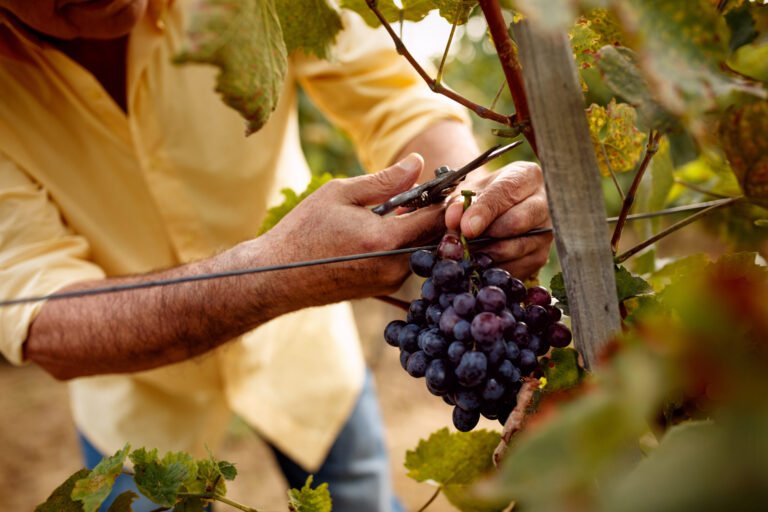Picture this: the air is crisp, the sun’s glow softens the rolling hills, and the leaves on the vines turn a golden hue. It’s grape harvest season in Europe—a time filled with energy, tradition, and joy as wine regions come alive with excitement. The annual grape harvest is one of the most magical times of the year for wine lovers and winemakers alike. Whether you’re a wine connoisseur or just love a good celebration, this season is the heart and soul of Europe’s wine culture.

Grape Harvest: A Tradition Rooted in History
Grape harvesting in Europe is more than just picking grapes; it’s a tradition that has been passed down through generations, going back centuries. Historically, it was a communal event where families, friends, and neighbours gathered to help bring in the season’s bounty. Back in the day, the harvest was all done by hand, with people singing, laughing, and sharing food as they worked. It was gruelling but rewarding, and it often ended with a big feast to celebrate the hard work.

The harvest season in Europe typically runs from August to October, though it varies depending on the region, the grape variety, and even the year’s weather. Over the centuries, the tools and techniques may have modernised, but the spirit of harvest—hard work, community, and celebration—remains just as strong.
A Fun Fact: The Tradition of Foot-Stomping Grapes

One quirky tradition that has endured in some parts of Europe is the art of foot-stomping grapes. This old-world technique, also called “treading,” involves getting into large wooden vats filled with freshly picked grapes and smashing them with your feet. It’s not just about nostalgia; this method is actually quite effective for gently crushing the grapes without breaking the seeds, which can release bitter flavours into the wine. wooden vats filled with freshly picked grapes and smashing them with your feetun and stomp some grapes yourself—barefoot, of course!
Celebrating the Harvest: Festivals and Traditions
Throughout Europe, wine regions celebrate harvest season with vibrant festivals that draw both locals and tourists. These festivals often include grape-picking competitions, processions, wine tastings, and lots of food (obviously!). Some of the most famous include:
Fête des Vendanges in Montmartre, Paris: This annual event celebrates the harvest with street parades, concerts, fireworks, and, of course, lots of wine. It’s a quirky twist to celebrate the vineyards of Paris.
Oktoberfest in Germany: While known for beer, wine also plays a role in some parts of Germany, particularly in Franconia. Here, the harvest is celebrated with “Federweißer,” a partially fermented young wine served with onion tart.

La Festa dell’Uva in Tuscany, Italy: This festival in Chianti is a picturesque celebration where visitors can enjoy grape stomping, traditional dances, and, most importantly, local wine paired with hearty Tuscan dishes.
The Grape Festival in Jerez, Spain: In Andalusia, the grape harvest is closely tied to the production of sherry. The celebration here includes traditional processions, wine tastings, and flamenco shows—an intoxicating combination!
How Harvest Season Has Evolved
Over time, the harvest season has evolved, especially with the advent of technology. What used to be a completely manual process can now be aided by machines, especially in large vineyards. However, many winemakers, particularly in Europe, still prefer hand-picking their grapes, believing that this delicate approach helps maintain the quality of the fruit and, ultimately, the wine.

Another significant change is how harvest season has become a tourist attraction. Regions such as Burgundy, Tuscany, and Rioja now welcome travellers who want to experience the magic of the harvest first-hand. Wine enthusiasts can participate in grape picking, join wine tours, and even take part in traditional harvest meals.
A Grape for Every Stage: Wine and Food Pairings
Harvest season in Europe doesn’t just vary by region; it also varies by the type of grape and when it’s harvested. Here’s a fun breakdown of wines from different stages of the harvest—and the perfect local dishes to pair them with.
1. Early Harvest Wine: Verdejo from Spain (Lunch)
Early harvest wines tend to have higher acidity and freshness. A classic example is the Verdejo from Spain, which is typically harvested in late August. This crisp white wine has bright citrus and green apple flavours—perfect for a light lunch.
Pairing: Try Verdejo with a fresh seafood paella, where the wine’s zesty notes beautifully complement the briny, savoury flavours of prawns, mussels, and calamari.

2. Mid-Harvest Wine: Chianti from Italy (Afternoon Snack)
By mid-September, it’s time for the main event. In Tuscany, this means Chianti—a classic red wine that’s harvested around this time. Chianti is known for its vibrant red fruit flavours, balanced acidity, and soft tannins, making it an ideal companion for an afternoon snack or “aperitivo.”
Pairing: Chianti pairs fantastically with bruschetta topped with tomatoes and basil, or for something richer, a slice of Tuscan pecorino. It’s a casual yet delicious way to enjoy an afternoon of harvest festivities.

3. Late Harvest Wine: Sauternes from France (Dinner)
Late harvest wines are often sweet and luscious because the grapes are left on the vine longer, allowing them to develop more sugar. A famous example is Sauternes, a decadent dessert wine from Bordeaux, harvested in October.
Pairing: For dinner, serve Sauternes with foie gras or a platter of blue cheese, such as Roquefort. The wine’s honeyed sweetness is the perfect match for the rich, salty flavours of these indulgent dishes.

A Celebration of Life, Wine, and Food
The grape harvest season in Europe is a celebration of life itself. It’s about tradition, hard work, and, above all, enjoyment. Whether you’re sipping an early harvest wine on a sunny afternoon or savouring a rich late harvest glass by the fire, the essence of the season is in the joy it brings. Next time harvest season rolls around, why not raise a glass and toast to the time-honoured traditions, the festivals, and the delicious pairings that make Europe’s wine regions so special? Santé!
